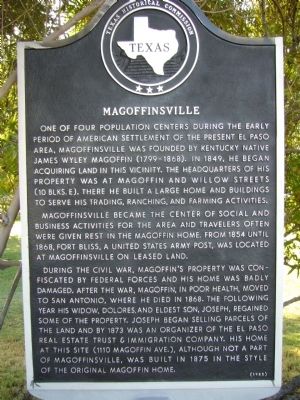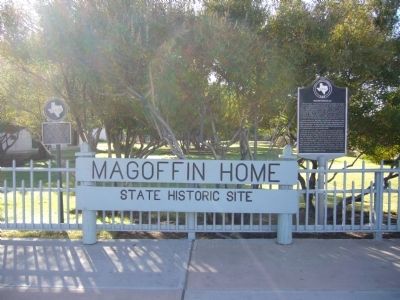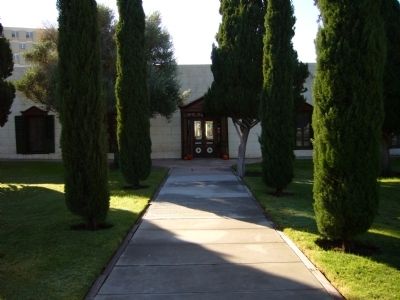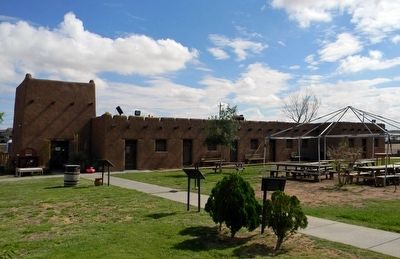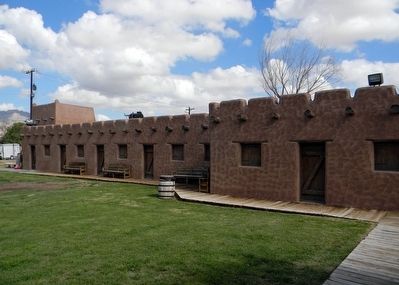El Paso in El Paso County, Texas — The American South (West South Central)
Magoffinsville
Magoffinsville became the center of social and business activities for the area and travelers often were given rest in the Magoffin home. From 1854 until 1868, Fort Bliss, a United States Army post, was located at Magoffinsville on leased land.
During the Civil War, Magoffin's property was confiscated by Federal forces and his home was badly damaged. After the war, Magoffin, in poor health, moved to San Antonio, where he died in 1868. The following year his widow, Dolores, and eldest son, Joseph, regained some of the property. Joseph began selling parcels of the land and by 1873 was an organizer of the El Paso Real Estate Trust and Immigration Company. His home at this site (1110 Magoffin Avenue), although not a part of Magoffinsville, was built in 1875 in the style of the original Magoffin Home.
Erected 1985 by Texas Historical Commission. (Marker Number 3184.)
Topics. This historical marker is listed in this topic list: Settlements & Settlers. A significant historical year for this entry is 1849.
Location. 31° 45.757′ N, 106° 28.642′ W. Marker is in El Paso, Texas, in El Paso County. Marker is on Magoffin Avenue, on the right when traveling east. Touch for map. Marker is at or near this postal address: 1110 Magoffin Avenue, El Paso TX 79901, United States of America. Touch for directions.
Other nearby markers. At least 8 other markers are within walking distance of this marker. Magoffin Homestead (here, next to this marker); Nine of Primitive El Paso's Patriotic Heroes (approx. 0.6 miles away); The Martin Building (approx. 0.6 miles away); Singer Building (approx. 0.6 miles away); First Baptist Church of El Paso (approx. 0.6 miles away); Elite Confectionary (approx. 0.6 miles away); Hotel Cortez (approx. 0.7 miles away); John Wesley Hardin (approx. 0.7 miles away). Touch for a list and map of all markers in El Paso.
Also see . . .
1. Magoffinsville Had Lasting Influence on El Paso. (Submitted on November 22, 2010.)
2. James Wiley Magoffin. A biography of James Magoffin from the Magoffin Home State Historic Texas Historical Commission website. (Submitted on November 22, 2010.)
Credits. This page was last revised on June 16, 2016. It was originally submitted on November 17, 2010, by Bill Kirchner of Tucson, Arizona. This page has been viewed 909 times since then and 58 times this year. Photos: 1, 2, 3. submitted on November 17, 2010, by Bill Kirchner of Tucson, Arizona. 4, 5. submitted on September 1, 2013, by PaulwC3 of Northern, Virginia. • Craig Swain was the editor who published this page.
